You are using an out of date browser. It may not display this or other websites correctly.
You should upgrade or use an alternative browser.
You should upgrade or use an alternative browser.
Castle Hill Home brew Competition 2013
- Thread starter Bribie G
- Start date

Help Support Australia & New Zealand Homebrewing Forum:
This site may earn a commission from merchant affiliate
links, including eBay, Amazon, and others.
Fatgodzilla
Beer Soaked Philosopher
- Joined
- 22/5/07
- Messages
- 4,459
- Reaction score
- 117
thankfully sanity prevails and that horse swill is relegated to the weirdos comps where it belongs!! -_-Ïm just stoked that my mead took the highest score of the comp. now to get the aabc to recognise meads and ciders.
Well done all - sorry I couldn't get there (again). Missed the fun (though I was at a pretty good substitute event!!!)
By the way, happy birthday Barls you old bastard!!!!!!!
waggastew
Well-Known Member
- Joined
- 7/1/10
- Messages
- 868
- Reaction score
- 310
Long Post Warning!
Over the weekend I was lucky enough to go along and help out at the NSW Homebrew Comp at the Castle Hill Showground. I have been entering beers for a few years now but wanted to get a close-up look at the logistics, the judging and also meet some of the faces behind the names on AHB.
Below is an overview of my weekend, some photos and some musings on the comp. Please note that all info below is my impression/opinion and not representative of the NSW Comp guys (although Stu did say he was more than happy for me to post my experience)
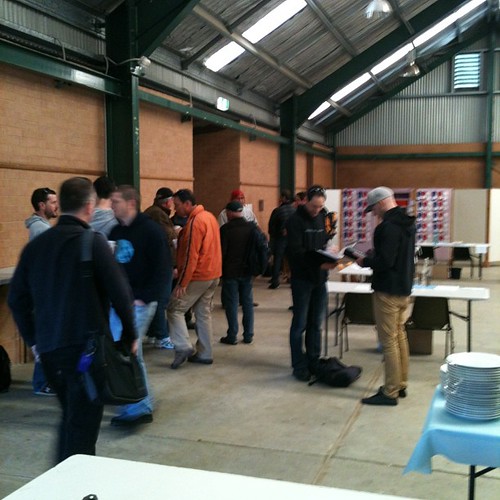
Got to the showground at 9am Saturday and immediately got chatting to some of AHB’s resident celebrities. The organiser Stu had already been there for some time that morning and I believe that he and a select crew had been judging on Friday night to get a head start on the over 500 beers entered.
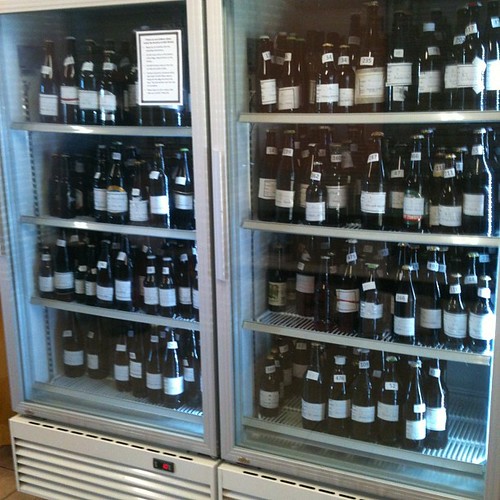
After a quick intro the stewards launched into serving up the calibration beers to the judges. The judges for a particular style receive a commercial example of a beer in the category they are judging. The purpose of this is to ensure that the scores of each of the judges in that category are about the same, and also I assume to wash the taste of toothpaste/coffee/cocoa pops out of their mouths.
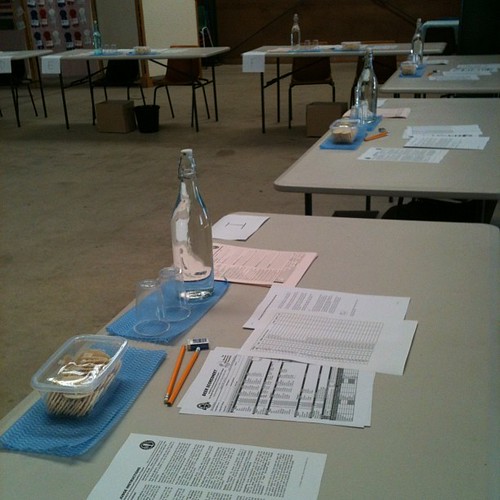
My job for that morning was to co-steward the amber/dark lager section. As a steward you essentially do the following:
- Retrieve the beer out of the fridge (often well before time to let it warm up a little if appropriate for style)
- Open it, pour about 300mL into a jug noting any gushing etc. For the weizen’s that I stewarded on Sunday I also had to rouse the yeast
- Bring the jug to the judges, relay entry number, pour the beer (although some judges preferred to do this themselves)
- After they had finished judging you cleared up the dirty glasses and jug, collected and checked score sheets, and tallied scores
- If the beer scored highly it would be recapped and placed in the fridge for the mini-BOS judging
In between all that there is plenty of washing up, stacking bottles, putting out clean glasses etc. Even that was fun with plenty of banter between the stewards and lots of tasting of any of the higher scoring beers that came back.

One of my first observations of the main process was that the judges take a lot of time to analyse every beer. The average was about 15 minutes although some beers took significantly longer. All the judges I saw took the time to suggest changes if needed and really ensure their judging was accurate. Each beer was judged by two judges and they often conferred with each other and would even seek a third opinion from Stu or another judge if they were unsure.
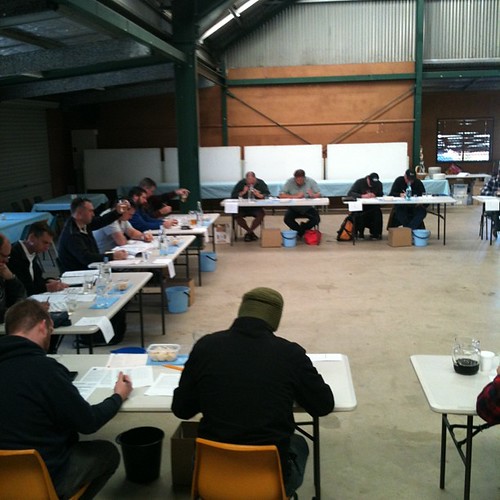
At the end of the judging of each category typically the top 3-6 beers would be re-poured and judged against each other in a mini-Best-of-Show. Two judges would debate the merit of each beer and then come up with 1st, 2nd, 3rd, and highly commended. This process was independent of the earlier judging (no main round scores were shown) and tended to be based on overall impression rather than spending 15 minutes on each beer. This helps to overcome inconsistencies between scoring by judges and I think results in the best beer winning.
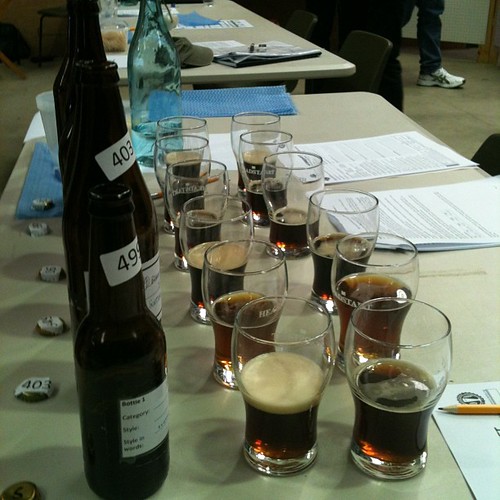
One of the perks of going to the comp was getting to taste the wining beers. I got to taste great examples of styles that we rarely see as commercial styles in Australia (think Barleywine etc) as well as calibrate my tastebuds around what judges look for in styles I like.
After a splendid lunch prepared by the lovely ladies of the Show Society the next round of judging began. I was lucky enough to get a guernsey judging the Porter category. The judging process was a big eye opener on how much concentration was needed to judge beer. For me the beers I judged tended to fall into three categories:
1. Obvious problems e.g. infection, way out of style
2. Overall to style but lacking oomph/key descriptor of style
3. To style, great beers, nit picking to find problems
The thing that hit home was that to win comps your must really pay attention to the guidelines. It is not a ‘best beer’ comp, but a ‘best beer in the style’ comp. A good example I judged in the Robust Porter style that presented with a big sweet chocolate character. It was a nice beer, chocolate lovers would drool, but it just didn’t fit the description. Of course that raises the old argument of brewing for comps or your own tastes.
Sunday morning was IPA’s, Bitters, American Pale Ales etc. I was stewarding Wheat and Rye beers and got to sample a few along the way. Most of the weizens really lacked the pilsener malt quality and lent heavily on the phenolics. The judges on the IPA’s really had to work hard with lupilin threshold a real risk.
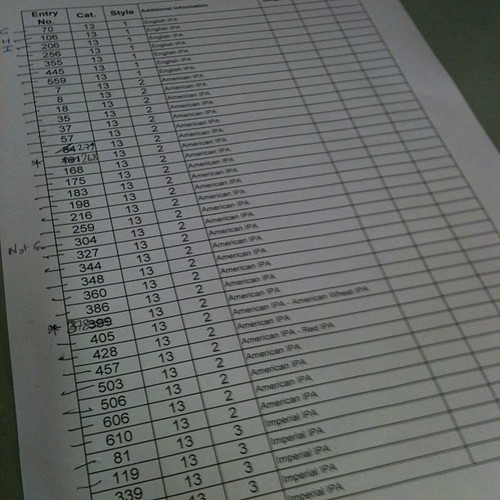
In the afternoon I continued with the wheats and then switched to the specialty category. There were some VERY interesting descriptors including a beer with Chia seeds in it! My Dad got to judge the Farmhouse category in this session, something he really enjoyed. The guidance of his co-judge was amazing, he really took the time to ensure they both got it right. They did however get off to a rough start with their first beer a Belgian Wit that had the colour of a brown ale.
Others were judging Old Ales/Strong Stouts and needed plenty of stamina to plough through the high ABV. Still even those guys remained (relatively) sober and seemed to be quite impressed with the standard of entries.
A big thanks to the whole crew who made me feel most welcome. In particular Stu for letting me Steward and Judge, Barls and Les for talking me through the judging process, and Kelly for the guidance re: stewarding. Every person involved was friendly, helpful and only too willing to chat beer and comps and let me pick their brains for nuggets of info.
Lastly I would encourage everyone reading this to get involved in their local/state/national comps. They run on love and passion and are really very fragile things. Without support and warm bodies to do organise and run them they have a habit of dying very quickly.
Stew
Over the weekend I was lucky enough to go along and help out at the NSW Homebrew Comp at the Castle Hill Showground. I have been entering beers for a few years now but wanted to get a close-up look at the logistics, the judging and also meet some of the faces behind the names on AHB.
Below is an overview of my weekend, some photos and some musings on the comp. Please note that all info below is my impression/opinion and not representative of the NSW Comp guys (although Stu did say he was more than happy for me to post my experience)

Got to the showground at 9am Saturday and immediately got chatting to some of AHB’s resident celebrities. The organiser Stu had already been there for some time that morning and I believe that he and a select crew had been judging on Friday night to get a head start on the over 500 beers entered.

After a quick intro the stewards launched into serving up the calibration beers to the judges. The judges for a particular style receive a commercial example of a beer in the category they are judging. The purpose of this is to ensure that the scores of each of the judges in that category are about the same, and also I assume to wash the taste of toothpaste/coffee/cocoa pops out of their mouths.

My job for that morning was to co-steward the amber/dark lager section. As a steward you essentially do the following:
- Retrieve the beer out of the fridge (often well before time to let it warm up a little if appropriate for style)
- Open it, pour about 300mL into a jug noting any gushing etc. For the weizen’s that I stewarded on Sunday I also had to rouse the yeast
- Bring the jug to the judges, relay entry number, pour the beer (although some judges preferred to do this themselves)
- After they had finished judging you cleared up the dirty glasses and jug, collected and checked score sheets, and tallied scores
- If the beer scored highly it would be recapped and placed in the fridge for the mini-BOS judging
In between all that there is plenty of washing up, stacking bottles, putting out clean glasses etc. Even that was fun with plenty of banter between the stewards and lots of tasting of any of the higher scoring beers that came back.

One of my first observations of the main process was that the judges take a lot of time to analyse every beer. The average was about 15 minutes although some beers took significantly longer. All the judges I saw took the time to suggest changes if needed and really ensure their judging was accurate. Each beer was judged by two judges and they often conferred with each other and would even seek a third opinion from Stu or another judge if they were unsure.

At the end of the judging of each category typically the top 3-6 beers would be re-poured and judged against each other in a mini-Best-of-Show. Two judges would debate the merit of each beer and then come up with 1st, 2nd, 3rd, and highly commended. This process was independent of the earlier judging (no main round scores were shown) and tended to be based on overall impression rather than spending 15 minutes on each beer. This helps to overcome inconsistencies between scoring by judges and I think results in the best beer winning.

One of the perks of going to the comp was getting to taste the wining beers. I got to taste great examples of styles that we rarely see as commercial styles in Australia (think Barleywine etc) as well as calibrate my tastebuds around what judges look for in styles I like.
After a splendid lunch prepared by the lovely ladies of the Show Society the next round of judging began. I was lucky enough to get a guernsey judging the Porter category. The judging process was a big eye opener on how much concentration was needed to judge beer. For me the beers I judged tended to fall into three categories:
1. Obvious problems e.g. infection, way out of style
2. Overall to style but lacking oomph/key descriptor of style
3. To style, great beers, nit picking to find problems
The thing that hit home was that to win comps your must really pay attention to the guidelines. It is not a ‘best beer’ comp, but a ‘best beer in the style’ comp. A good example I judged in the Robust Porter style that presented with a big sweet chocolate character. It was a nice beer, chocolate lovers would drool, but it just didn’t fit the description. Of course that raises the old argument of brewing for comps or your own tastes.
Sunday morning was IPA’s, Bitters, American Pale Ales etc. I was stewarding Wheat and Rye beers and got to sample a few along the way. Most of the weizens really lacked the pilsener malt quality and lent heavily on the phenolics. The judges on the IPA’s really had to work hard with lupilin threshold a real risk.

In the afternoon I continued with the wheats and then switched to the specialty category. There were some VERY interesting descriptors including a beer with Chia seeds in it! My Dad got to judge the Farmhouse category in this session, something he really enjoyed. The guidance of his co-judge was amazing, he really took the time to ensure they both got it right. They did however get off to a rough start with their first beer a Belgian Wit that had the colour of a brown ale.
Others were judging Old Ales/Strong Stouts and needed plenty of stamina to plough through the high ABV. Still even those guys remained (relatively) sober and seemed to be quite impressed with the standard of entries.
A big thanks to the whole crew who made me feel most welcome. In particular Stu for letting me Steward and Judge, Barls and Les for talking me through the judging process, and Kelly for the guidance re: stewarding. Every person involved was friendly, helpful and only too willing to chat beer and comps and let me pick their brains for nuggets of info.
Lastly I would encourage everyone reading this to get involved in their local/state/national comps. They run on love and passion and are really very fragile things. Without support and warm bodies to do organise and run them they have a habit of dying very quickly.
Stew
barls
causer of chaos and mayhem
- Joined
- 30/1/05
- Messages
- 6,164
- Reaction score
- 779
well written and summarised stew. look forward to seeing you again next year if not before.
ive got to say everyone there was nice and friendly and if they werent sure on things they asked, but this is how it should be.
ive got to say everyone there was nice and friendly and if they werent sure on things they asked, but this is how it should be.
warra48
I've drunk all my homebrew and I'm still worried.
Great post by waggastew.
Gives a good insight into the whole process.
Gives a good insight into the whole process.
Stuster
Big mash up
- Joined
- 16/4/05
- Messages
- 5,216
- Reaction score
- 72
Love the write up, Stew. Thanks for coming along and doing a lot over the weekend.
Score sheets, certificates and most prizes were posted out today. The post office woman was very good about received 130 or so items to post, but couldn't guarantee that all would be posted out today. She did say she'd try though. So could be in your letter box tomorrow, but should definitely be there by Monday.
Prizes kindly donated by the homebrew shops will be coming soon after I hope (I just have to let them know then winners' names and addresses first ).
).
Score sheets, certificates and most prizes were posted out today. The post office woman was very good about received 130 or so items to post, but couldn't guarantee that all would be posted out today. She did say she'd try though. So could be in your letter box tomorrow, but should definitely be there by Monday.
Prizes kindly donated by the homebrew shops will be coming soon after I hope (I just have to let them know then winners' names and addresses first
Hoppy Mad
Member
- Joined
- 20/8/09
- Messages
- 13
- Reaction score
- 0
Thanks for the kind words Stew. I enjoyed judging with your Dad and getting his insights into each beer.waggastew said:My Dad got to judge the Farmhouse category in this session, something he really enjoyed. The guidance of his co-judge was amazing, he really took the time to ensure they both got it right. They did however get off to a rough start with their first beer a Belgian Wit that had the colour of a brown ale.
Brendan
barls
causer of chaos and mayhem
- Joined
- 30/1/05
- Messages
- 6,164
- Reaction score
- 779
Just got this from stu who is the organizer
First, to let you know that the Castle Hill competition appears to have
been the biggest amateur homebrew competition that has been held in
Australia to date. It was a very busy weekend with the 556 entries from the
126 entrants being judged by 32 judges with the help of 20 stewards
First, to let you know that the Castle Hill competition appears to have
been the biggest amateur homebrew competition that has been held in
Australia to date. It was a very busy weekend with the 556 entries from the
126 entrants being judged by 32 judges with the help of 20 stewards
black_labb
Well-Known Member
- Joined
- 16/2/10
- Messages
- 1,022
- Reaction score
- 121
Dissapointed my beers didnt make it. Left them with someone to drop off but being in the middle of siberia for 3 months I didn't get around to giving them the entering details when they became available (I had already left)
Any judges interested in analysing a few for my feedback? I have an excellent belgian dark strong that I had high hopes for and a couple other good ones.
Any judges interested in analysing a few for my feedback? I have an excellent belgian dark strong that I had high hopes for and a couple other good ones.
Josh
WSB
black_labb said:Dissapointed my beers didnt make it. Left them with someone to drop off but being in the middle of siberia for 3 months I didn't get around to giving them the entering details when they became available (I had already left)
Any judges interested in analysing a few for my feedback? I have an excellent belgian dark strong that I had high hopes for and a couple other good ones.
Happy to pour it into a jug and drink the remaining 3/4 bottle for you Barls.barls said:sure pm me.
Love the write up and photos! Thanks to everyone who had a part to play in the comp - seemed to run like a well oiled machine.
Appreciate the opportunity to line my beers up against the rest of Nsw and get the considered feedback.
Thanks
Rod
Appreciate the opportunity to line my beers up against the rest of Nsw and get the considered feedback.
Thanks
Rod
barls
causer of chaos and mayhem
- Joined
- 30/1/05
- Messages
- 6,164
- Reaction score
- 779
bet you would. Come and share a glass with me josh.Josh said:Happy to pour it into a jug and drink the remaining 3/4 bottle for you Barls.
black_labb
Well-Known Member
- Joined
- 16/2/10
- Messages
- 1,022
- Reaction score
- 121
Can I sit under the table and listen? Throw enough sips under the table and I may get extra points for tight and long lasting head.
Stuster
Big mash up
- Joined
- 16/4/05
- Messages
- 5,216
- Reaction score
- 72
Yes, though these will follow after next year's show (except for those who were there on Sunday and took them away with them). So I think the next show will be in March next year I think.
Also, if there are more people who did not receive their ribbons from last year's show, give me a PM or email and I will chase that up.
Also, if there are more people who did not receive their ribbons from last year's show, give me a PM or email and I will chase that up.
Barry
To thine own self brew
- Joined
- 7/12/02
- Messages
- 1,197
- Reaction score
- 97
The Brew Shop is going to offer to send down entries on a skip (small pallet). I will speak to them today and confirm details. You still need to pack your entries safely and get them to the store on time (date to be confirm).
Barry
To thine own self brew
- Joined
- 7/12/02
- Messages
- 1,197
- Reaction score
- 97
The Brew Shop will receive entries from NSW brewers who have qualified for the Nationals. Closing date at The Brew Shop is 4pm Saturday 19th October. If you can't drop them off at the shop it would be best, for the entries, to send them straight to Canberra.
They will put them on a skip/small pallet, wrap the skip and send them on the Monday. This will ensure that they stay upright and reduce some of dangers associated with couriers.
They will put them on a skip/small pallet, wrap the skip and send them on the Monday. This will ensure that they stay upright and reduce some of dangers associated with couriers.
Similar threads
- Replies
- 0
- Views
- 2K
- Replies
- 3
- Views
- 2K
- Replies
- 0
- Views
- 687
- Replies
- 22
- Views
- 5K
- Replies
- 252
- Views
- 25K



